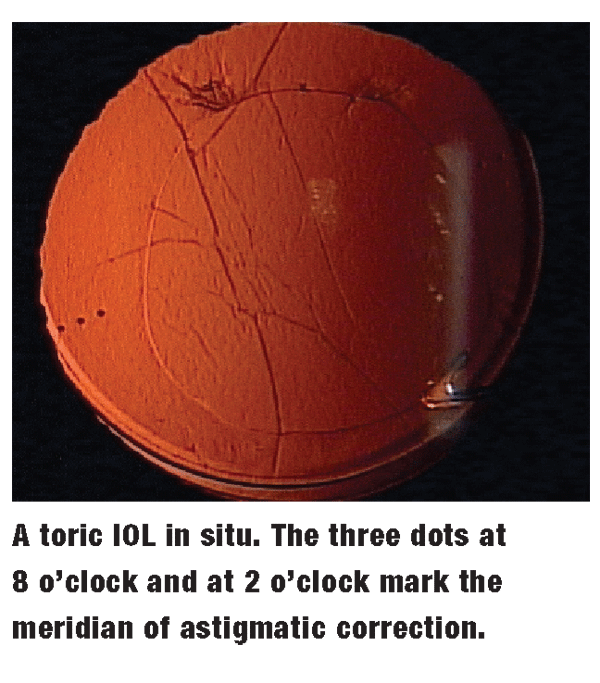 Q: I have a cataract patient with more than 2.00D of cylinder. What procedure should I recommend to eliminate the astigmatism?
Q: I have a cataract patient with more than 2.00D of cylinder. What procedure should I recommend to eliminate the astigmatism?
A: First, evaluate the astigmatism by keratometry, topography and/or IOL Master (Zeiss), says Howell M. Findley, O.D., co-founder of Commonwealth Eye Surgery, Lexington, Ky.
Once youve determined the patients astigmatism and its axis, there are three basic surgical options used to correct it in conjunction with a cataract procedure:
Surgical incision, such as astigmatic keratometry (AK) or a limbal relaxing incision (LRI), performed at the time of cataract extraction.
Insertion of a toric intraocular lens rather than a standard IOL.
Refractive surgery, such as LASIK or photorefractive keratectomy (PRK), performed after the eye has stabilized.
There are pros and cons for each option, Dr. Findley says.
The advantage to AK (an incision in the peripheral cornea) or LRI (an incision in the corneal limbus along the steep meridian) is that the incision is performed at the time of cataract extraction, so there is an immediate improvement in uncorrected visual acuity, Dr. Findley says. Also, although Medicare does not cover the procedure, the incision does not require an exorbitant out-of-pocket expense for the patient. The disadvantage is that AK and LRI are imprecise in correcting the astigmatism (AK more so than LRI), and their results become more unpredictable as the degree of astigmatism increases.
 For a toric IOL, the advantages include a very high degree of accuracy, immediate improvement of uncorrected visual acuity, and the need for only one procedure. The only disadvantage is the limited degree of astigmatic powers available, Dr. Findley says. But, these will be expanded in the near future. Cost is another consideration. Medicare does not cover a toric IOL. But, as of January 2007, patients are allowed to pay the extra expense out of pocket.
For a toric IOL, the advantages include a very high degree of accuracy, immediate improvement of uncorrected visual acuity, and the need for only one procedure. The only disadvantage is the limited degree of astigmatic powers available, Dr. Findley says. But, these will be expanded in the near future. Cost is another consideration. Medicare does not cover a toric IOL. But, as of January 2007, patients are allowed to pay the extra expense out of pocket.
The advantage of LASIK or PRK is the high degree of precision. The disadvantages include the delay until resolution of the cataract procedure and the significant out-of-pocket expense, Dr. Findley says.
Today, precision is paramount as fewer patients are willing to tolerate less-than-perfect vision. Cataract surgery has become a refractive surgical procedure, says optometrist Daryl Mann, center director of SouthEast Eye Specialists, in
Also, technological advancements have made this option more reliable. The acrylic material [of Alcons AcrySof Toric IOL] is ideal for the correction of corneal astigmatism, says surgeon Lance Ferguson, M.D., also co-founder of Commonwealth Eye Surgery. The acrylic material is sticky, and therefore has greater rotational stability. We see minimal, if any, rotation with this lens, and we have a zero return rate to the O.R.
Toric IOLs range in power from 1.00D to 3.50D of astigmatic correction. Until this range expands, patients with higher amounts of corneal astigmatism may require a second procedure, such as PRK or LASIK, Dr. Ferguson says.
O.D.s can help their patients and their surgeon by identifying in advance those who are candidates for toric IOLs, Dr. Findley says. That includes patients with at least 0.75D of against-the-rule astigmatism or 1.50D of with-the-rule astigmatism.
Toric IOLs must be special ordered, so these patients are not candidates for same-day surgery, he says. And, inform them of the added expense of this option. Otherwise, Dr. Findley says, the post-op routine is the same for these patients as for any cataract patient.











